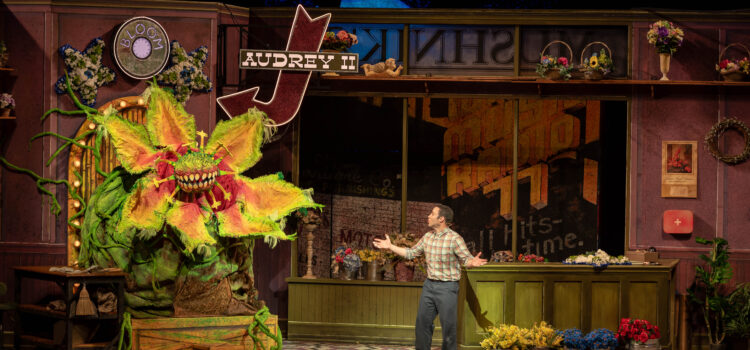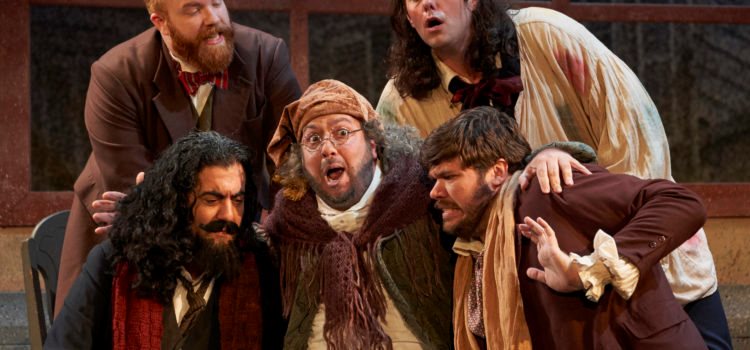By Lynn Venhaus
A mod, madcap rock musical, “Little Shop of Horrors” is a perfect palate cleanser after two serious prestige productions this season. The Muny merrily delivers this bright bouquet of quirky black comedy to ride out an inevitable midsummer St. Louis heat wave.
A pleasant evening of escapist entertainment, the campy cult classic shows why it is an enduring ‘little engine that could’ – a zippy two-hour musical that puts the bop in doo wop and delights with kooky characters while glossing over what is potentially icky with a lightness of being.
It is, after all, a horror comedy – and one loosely based on a cheesy 1960 movie meant to be a goofy cautionary tale about the atomic age. Designed to satirize science fiction, B-movies, the Faustian bargain and even musical comedy, the appeal of “Little Shop of Horrors” has now reached multiple generations.
Perhaps a maniacal plant that feeds on human flesh and blood doesn’t sound appealing, but in its fourth presentation and the first one since 2011, the Muny’s creative team knows how to get it just right, winning us over with the show’s lively tempo and unpretentious yet irreverent attitude.
Maybe when you discover Audrey II, the freakish carnivorous plant picked up by botanically curious Seymour in Chinatown during a solar eclipse, is a dastardly schemer from outer space that takes over Seymour’s life, it’s more palatable.
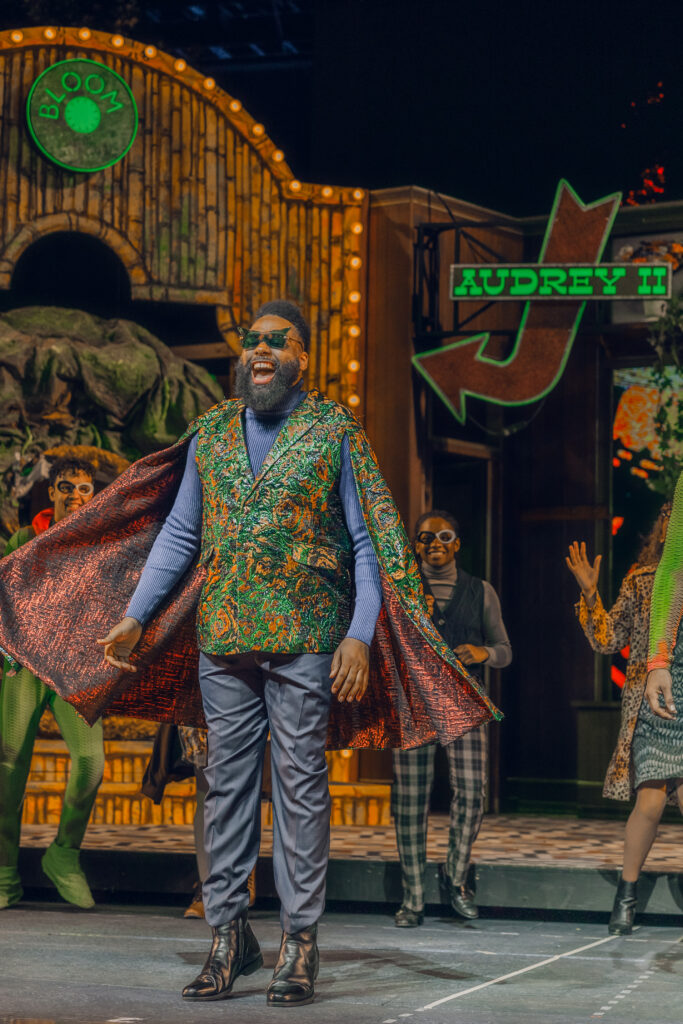
“Two-eys” hearty appetite for destruction is the catalyst for Seymour blooming where he’s planted — providing him with a taste of fame and opportunities, the allure of celebrity leading to a possible livin’ large lifestyle that he’s been longing for – a dare to dream scenario.
And let’s talk about that spectacular centerpiece of the show – the Venus flytrap-like plant that grows to epic proportions is a doozy, a marvel of engineering and innovation designed by James Ortiz. (I was fortunate to see this puppet designer’s remarkable work in the recent Broadway revival of “Into the Woods,” and this guy’s got game.)
His neon green one-of-a-kind otherworldly monstrosity was created just for the Muny run. Four puppeteers impressively guide this mean green machine, with astonishing mobility credited to Travis Patton as “Audrey II Manipulation.” Just watching Patton move with Swiss-watch precision is fascinating, and he deservedly takes a bow during the curtain call.
The bloodthirsty, pushy character is voiced by Nicholas Ward with devilish charm. His “Feed Me (Git It)” is saucy, and his “Suppertime” is unsettling, those robust pipes a delight to hear – even if Audrey II’s endgame is world domination. Of course Ward played Mufasa in “The Lion King” on Broadway. You may recall his impressive vocal performance as Caiaphas in “Jesus Christ Superstar” here in 2017.
The fact that this intimate show feels comfortably at home on the Muny stage is a major achievement, for striking the right tone between playful and offbeat with fear and murder is not easy to do given the source material, and its unconventional backstory. It’s far more complicated than it appears, and this small cast and crew make it appear effortless.
What first became a low-budget Roger Corman horror B-movie in 1960, featuring an unknown Jack Nicholson as a masochistic dental patient (cut out of stage version) and written by Charles Griffith, was turned into an off-Broadway musical sensation penned by none other than those cheeky composing pals Howard Ashman (book and lyrics) and Alan Menken (music) in 1982.
Turned into a movie musical in 1986, the stage version finally made it to Broadway in 2003. It was revived off-Broadway in 2019, with the top-shelf cast of Jonathan Groff, Tammy Blanchard and Christian Borle.
Now household names, the late Ashman and Menken’s star rose with their Disney collaborations – “The Little Mermaid,” “Beauty and the Beast “and “Aladdin.” After Ashman’s death in 1991, Menken wrote music with other lyricists to maintain a Hall of Fame career – “Newsies,” “Pocahontas,” “The Hunchback of Notre Dame” and “Hercules” among a long list that has earned 8 Academy Awards, 11 Grammy Awards and 1 Tony (4 nominations).
Menken, unintentionally, is being showcased this season with three productions – “the kids’ show” “Beauty and the Beast” and closer “Sister Act,” displaying his range.
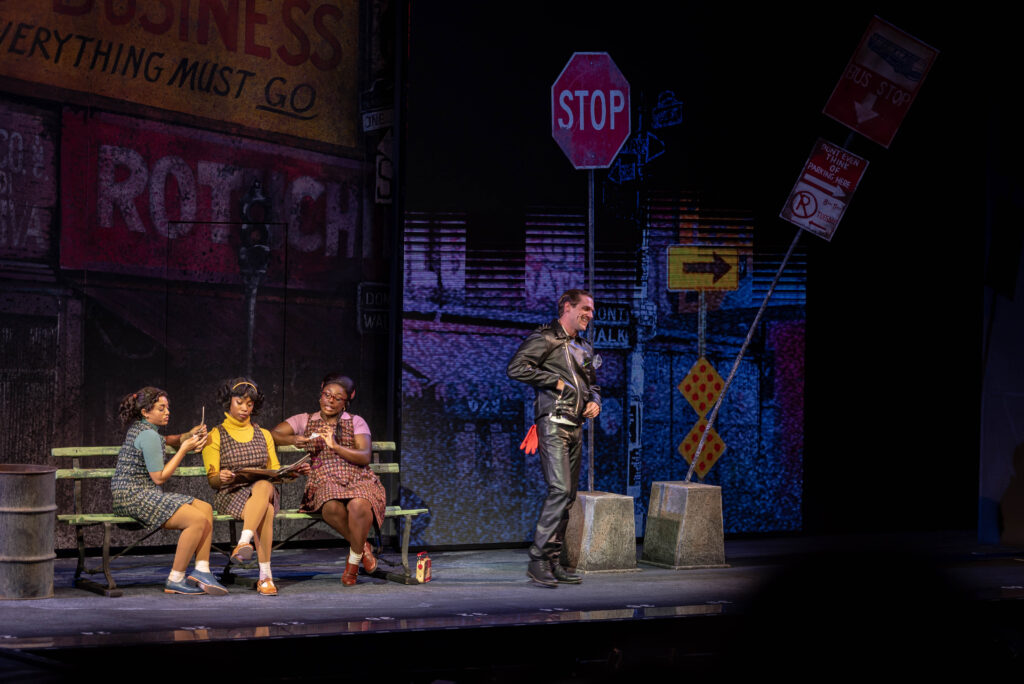
This Ashman-Menken score shows their compatibility, sense of humor, understanding of music history, and the ability to change styles fluidly. (For a deeper dive into their beginnings, “Howard” is a terrific documentary available streaming on Disney+).
Director Maggie Burrows keeps the pace crisp and snappy, as she did in “On Your Feet!” and last year’s “Legally Blonde,” and so does her collaborator, choreographer William Carlos Angulo. Along with music director Andrew Graham, they added the oomph to Ashman-Menken’s genial numbers. Orchestrations are by Robert Merkin and vocal arrangements by Robert Billig.
The high-spirited ensemble frolics with glee. The two leads are polished pros with strong voices – three-time Tony nominee Robin De Jesus and reliable Muny favorite Patti Murin are smoothly in sync as florist shop co-workers, genuine in song and performance. They sing from the heart in the romantic ballad “Suddenly, Seymour,” and have a good time with “Closed for Renovation” and “Call Back in the Morning.”
Working hard as the sweet and lovable dork Seymour, De Jesus draws us in to the poor orphan’s tough life on Skid Row, but the dead-end hasn’t hardened him to hope, even though he appears hapless. He’s craving change, noticeably so in “Grow for Me.”
Undeterred, he won’t stop trying to win over Audrey, the love of his life who feels unworthy of anyone’s affection. Without a shred of self-esteem, she is the victim of an awful, abusive boyfriend, which is the other ‘horror’ (after all, the title is plural). She delivers a heartrending “Somewhere That’s Green.”
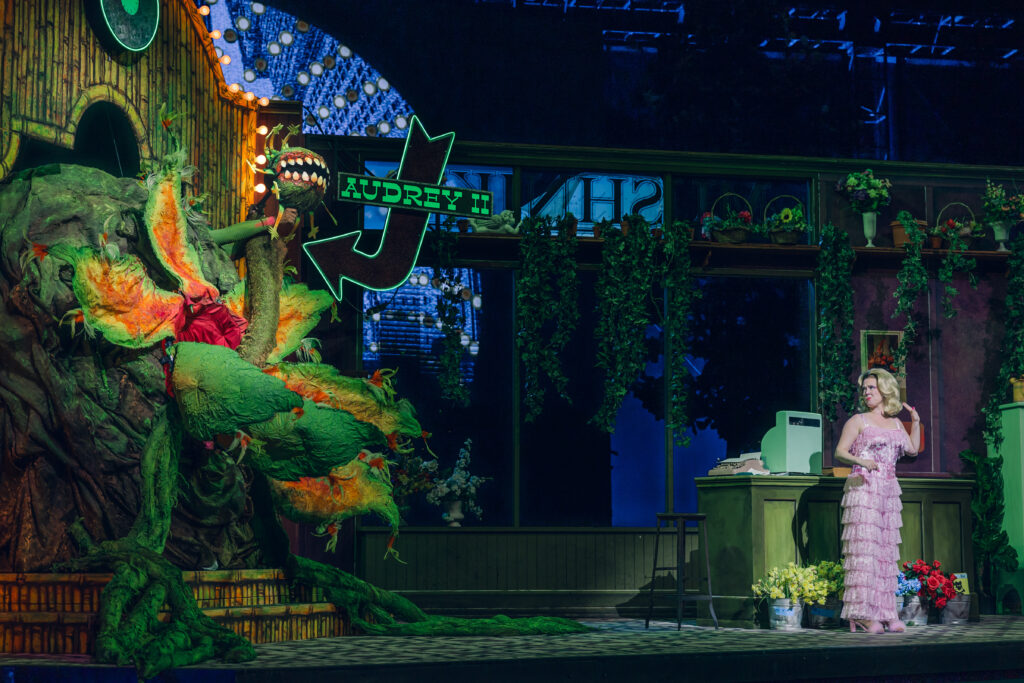
De Jesus’s humanity as conflicted Seymour comes through. And that’s usually a component evident in all his performances. He was last seen here as the title character in the pre-Broadway tryout of “Aladdin” in 2012. The original Sonny in “In the Heights,” for which he was Tony-nominated, he also scored a nomination as housekeeper Jacob in “La Cage Aux Folles” and Emory in “The Boys in the Band” stage play revival. He reprised his role in the 2021 Netflix movie.
I first noticed him in the underrated indie gem, “Camp,” from 2003, as one of the young misfits at a performing arts summer camp. In 2021, he played opposite Andrew Garfield as Michael in the Lin-Manuel Miranda directed “tick, tick…Boom.”
Murin is an affable Audrey, just as she has engaged here as Paulette in last year’s “Legally Blonde,” as Ariel in “The Little Mermaid” and Roxie in “Chicago,” both in 2011. She originated the role of Princess Anna in Disney’s “Frozen” on Broadway.
Tony winner Michael McGrath gives shop owner Mr. Mushnik an edge, for he treats Seymour shabbily but does have comical lines. A longtime Muny performer, he won a Tony for “Nice Work If You Can Get It,” and was nominated for “Spamalot.”
The ensemble sparkles, especially Taylor Marie Daniel, Kennedy Holmes and Stephanie Gomerez as the Urchins girl group, an R&B trio honoring the Brill Building/early Motown songwriters with the names Chiffon, Crystal, and Ronnette.
They bring the pizzazz as the Greek chorus, harmonious and spunky in the Prologue, “Skid Row (Downtown),” “Da Doo,” “Don’t It Go to Show Ya Never Know,” and “Dentist!”
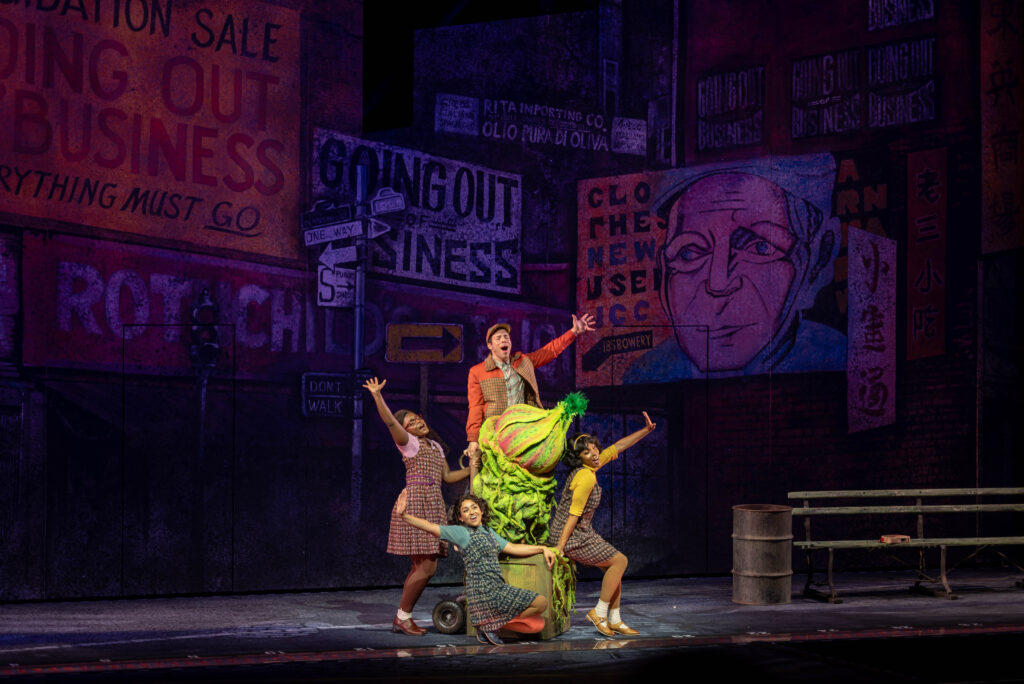
The meaty roles in supporting parts are one of the show’s selling points. Ryan Vasquez kills it as the sadistic dentist Orin Scrivello. He’s absurdly exaggerated in this plum part, especially in “Now (It’s Just the Gas).”
And he’s very funny as gaudily dressed assorted characters in the second act, showing a good-sport sense of humor in his Muny debut — and quite a range for an actor who played Alexander Hamilton and various founding fathers in “Hamilton” on Broadway.
The costumes are sensational, an integral part of the atmosphere. Costume Designer Leon Dobkowski created blasts from the past with the Urchins’ flashy fashions, and bosom-enhancing skin-tight outfits worn by Audrey that look like they were purchased from Frederick’s of Hollywood.
He also selected suitable nebbish attire worn by Seymour and Mushnik, and Kelly Jordan’s wig design also aided the retro look. Dobkowski won two St. Louis Theater Circle Awards for “Seussical” and “The Wiz,” and he has such a fun-loving eye.
The scenic design by Kristen Robinson is a striking grungy streetscape of an area that has seen better days, and an effectively shrewd interior of Mushnik’s Flower Shop, which includes subtle changes as the business prospers, and well-chosen pieces reflecting the economic fortunes. She tells the story well depicting those touches.
Greg Emetaz’s video design is seamless, deftly enhancing the set design and story progression with strong visuals.
This is a swiftly paced musical with a zest for fantasy, yet grounded in a dark side that is still amusing after all these years.
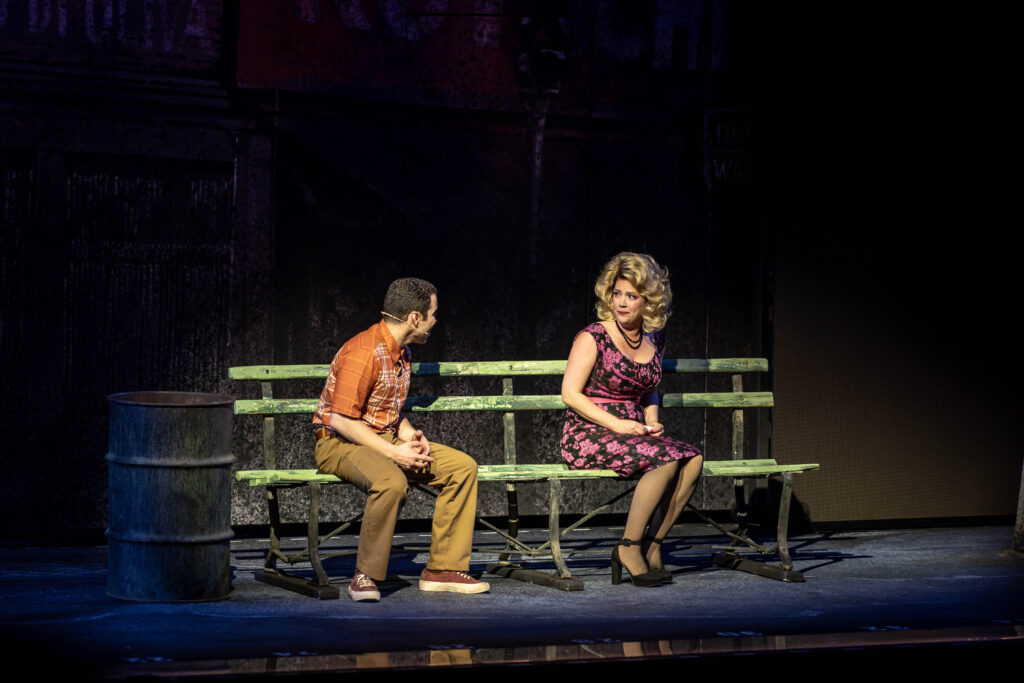
The Muny presents “Little Shop of Horrors” July 25-31 at 8:15 p.m. on the outdoor stage in Forest Park. For more information, visit: www.muny.org.

Lynn (Zipfel) Venhaus has had a continuous byline in St. Louis metro region publications since 1978. She writes features and news for Belleville News-Democrat and contributes to St. Louis magazine and other publications.
She is a Rotten Tomatoes-approved film critic, currently reviews films for Webster-Kirkwood Times and KTRS Radio, covers entertainment for PopLifeSTL.com and co-hosts podcast PopLifeSTL.com…Presents.
She is a member of Critics Choice Association, where she serves on the women’s and marketing committees; Alliance of Women Film Journalists; and on the board of the St. Louis Film Critics Association. She is a founding and board member of the St. Louis Theater Circle.
She is retired from teaching journalism/media as an adjunct college instructor.

